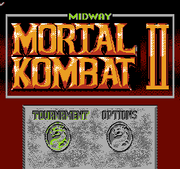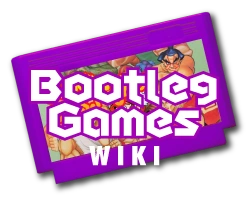(Adding categories) |
PopKorn Kat (talk | contribs) mNo edit summary |
||
| (20 intermediate revisions by 14 users not shown) | |||
| Line 1: | Line 1: | ||
| + | {{About|Hummer Team Version|Yoko Version|Mortal Kombat II (Yoko)}} |
||
{{Infobox game |
{{Infobox game |
||
| − | |name = Mortal Kombat II |
+ | |name = Mortal Kombat II |
| − | |image = |
+ | |image = File:MortalKombatIIlogo.png |
| ⚫ | |||
| − | |imagewidth = 250 |
||
| ⚫ | |||
| ⚫ | |||
| − | |developer = [[Hummer Team]] |
+ | |developer = [[Hummer Team]] |
| ⚫ | |||
| ⚫ | |||
| ⚫ | |||
| ⚫ | |||
| + | |date = July or August 1994 (?) |
||
| ⚫ | |||
| + | |engine = [[Street Fighter II Engine]] |
||
| − | |date = Unknown |
||
| − | | |
+ | |sound = [[Hummer Sound Engine]] |
| ⚫ | |||
| − | |sound = [[Hummer Sound Engine]] |
||
| ⚫ | |||
}} |
}} |
||
| − | '''''Mortal Kombat II''''' is |
+ | '''''Mortal Kombat II''''' is an unlicensed port of ''Mortal Kombat'' made by [[Hummer Team]]. According to the circuit board, the game was released in mid-1994. Both ''[[Kart Fighter]]'' and ''[[AV Bishoujo Senshi Girl Fighting]]'', which were released later, use an earlier version of this game's engine. |
| − | ==Overview== |
+ | == Overview == |
| + | [[File:MortalKombatIItitlescreen.png|thumb|left|''Mortal Kombat II''<nowiki>'</nowiki>s title screen / menu.]] |
||
| − | [[File:MortalKombatIItitlescreen.png|thumb|left|192px|Mortal Kombat II's Title Screen/Menu]]Despite the title, this game is actually a port of the first Mortal Kombat. (This was likely done as a form of selling the product as a sequel, a common trait with pirated games) Unfortunately, some features were cut from the game like fatalities and blood, the latter of which would be included in [[Mortal Kombat II Special]]. This leads to the possibility that it was based off the SNES port. |
||
| + | Despite the title, this game is actually a port of the first ''Mortal Kombat''. This was likely done as a form of selling the product as a sequel, a common trait with unlicensed NES games. While the game is mostly faithful to the original game graphics-wise, some features were cut from the game. These include fatalities and blood which are found only in ''[[Mortal Kombat II Special]]''. As such, it's possible that the game was based on the official SNES port. The game includes the seven standard characters, plus Shang Tsung (whose name is misspelt as Skang-Tsung) and Goro as playable characters. However, Goro is the same size as the other characters, probably due to the NES's limitations. It's also been suggested that this game is based on the official Game Boy port published a year earlier. Both ports lack the hidden character Reptile and feature Goro as a playable character (although Goro can be used from the start here, unlike the Game Boy version). |
||
| + | Special moves also don't work as they do in ''Mortal Kombat'', and some have been removed, again likely due to console limitations. For example, Sub-Zero's ice ball works like an ordinary fireball. Scorpion's spear has also been replaced with a similar fireball. Moves-wise, all characters (except Goro and Skang-Tsung) don't differ much from each other. |
||
| + | The arenas are largely faithful to the original game, though the order in which they appear aren't. The Courtyard for example, features animated monk spectators who clap when the round is over, though small details like the roof over Skang-Tsung are missing. The Courtyard also appears in most versions of the game as the third stage, where in the original version it's the first stage. |
||
| − | The game includes the seven standard characters, as well as Shang Tsung and Goro being playable characters. The specials don't work properly, functioning similarly to those from Street Fighter II. The graphics are taken from the original Mortal Kombat, but the logo was redone to add the "II" into the title. The game has different endings depending on the difficulty, although these are very basic which is to be expected from a pirate. |
||
| + | Various versions of Skang Tsung's Throne Room and the Palace Gates arenas can also be found in hacked versions. In ''Mortal Kombat III'', there are three Skang-Tsungs sitting in the background, for example. |
||
| ⚫ | |||
| + | |||
| − | * There are hacked versions of this, named Mortal Kombat II Turbo, Mortal Kombat III and Mortal Kombat III Turbo. The latter two expand the roster of characters by adding many recolours. |
||
| + | The soundtrack is mostly original, save for the title screen sting, the character select theme, and the Goro's Lair theme (which is really a lightly remixed version of the original Courtyard theme). |
||
| ⚫ | |||
| + | |||
| − | * Shang Tsung's name is misspelled as "Skang Tsung." |
||
| + | The game has different endings depending on the difficulty, setting although these are very basic which isn't unusual for a pirate game. |
||
| ⚫ | |||
| + | |||
| ⚫ | |||
| + | == Gallery == |
||
| ⚫ | |||
| + | <gallery> |
||
| − | * Most of the moves do not work properly, including Sub-Zero's ice move and Sonya's Square Punch. As well as this, Scorpion's spear is replaced with a fire toss. Add to this that a few moves are also missing from each character, which generally makes the gameplay of all seven characters, sans the bosses, exactly the same. |
||
| + | img20200309_14534282.jpg|''Mortal Kombat III Turbo'' Box. |
||
| + | img20200309_15031587.jpg|''Mortal Kombat III'' Box. |
||
| + | 20200309_153013.jpg|Cartridge. |
||
| + | 20200309_152947.jpg|Manual. |
||
| + | </gallery> |
||
| + | |||
| ⚫ | |||
| + | *As with many bootleg NES games, hacked versions exist: the know ones are ''Mortal Kombat II Turbo'', ''Mortal Kombat III'', ''Mortal Kombat III Turbo'', and ''Mortal Kombat 18''. |
||
| + | **The latter three have an expanded roster full of recolored characters. |
||
| + | **''Mortal Kombat 18'' drops the title screen and settings menu. Instead, it goes straight to the character select screen from the logo screen. |
||
| ⚫ | |||
| ⚫ | |||
| ⚫ | |||
| ⚫ | |||
| + | |||
| + | == External links == |
||
| + | *[http://tabmok99.mortalkombatonline.com/mkfamicom1.html Website with pictures and screenshots of the game] |
||
| + | *[http://tcrf.net/Mortal_Kombat_II_(NES) The Cutting Room Floor page with unused and hidden content] |
||
[[Category:Games]] |
[[Category:Games]] |
||
| ⚫ | |||
[[Category:Famicom/NES games]] |
[[Category:Famicom/NES games]] |
||
| ⚫ | |||
[[Category:Hummer Team]] |
[[Category:Hummer Team]] |
||
| + | [[Category:J.Y. Company]] |
||
| + | [[Category:1994 video games]] |
||
[[Category:Mortal Kombat games]] |
[[Category:Mortal Kombat games]] |
||
| + | [[Category:Ports]] |
||
Revision as of 18:05, 9 March 2020
- This article is about Hummer Team Version. For Yoko Version, see Mortal Kombat II (Yoko).
Mortal Kombat II is an unlicensed port of Mortal Kombat made by Hummer Team. According to the circuit board, the game was released in mid-1994. Both Kart Fighter and AV Bishoujo Senshi Girl Fighting, which were released later, use an earlier version of this game's engine.
Overview

Mortal Kombat II's title screen / menu.
Despite the title, this game is actually a port of the first Mortal Kombat. This was likely done as a form of selling the product as a sequel, a common trait with unlicensed NES games. While the game is mostly faithful to the original game graphics-wise, some features were cut from the game. These include fatalities and blood which are found only in Mortal Kombat II Special. As such, it's possible that the game was based on the official SNES port. The game includes the seven standard characters, plus Shang Tsung (whose name is misspelt as Skang-Tsung) and Goro as playable characters. However, Goro is the same size as the other characters, probably due to the NES's limitations. It's also been suggested that this game is based on the official Game Boy port published a year earlier. Both ports lack the hidden character Reptile and feature Goro as a playable character (although Goro can be used from the start here, unlike the Game Boy version). Special moves also don't work as they do in Mortal Kombat, and some have been removed, again likely due to console limitations. For example, Sub-Zero's ice ball works like an ordinary fireball. Scorpion's spear has also been replaced with a similar fireball. Moves-wise, all characters (except Goro and Skang-Tsung) don't differ much from each other.
The arenas are largely faithful to the original game, though the order in which they appear aren't. The Courtyard for example, features animated monk spectators who clap when the round is over, though small details like the roof over Skang-Tsung are missing. The Courtyard also appears in most versions of the game as the third stage, where in the original version it's the first stage.
Various versions of Skang Tsung's Throne Room and the Palace Gates arenas can also be found in hacked versions. In Mortal Kombat III, there are three Skang-Tsungs sitting in the background, for example.
The soundtrack is mostly original, save for the title screen sting, the character select theme, and the Goro's Lair theme (which is really a lightly remixed version of the original Courtyard theme).
The game has different endings depending on the difficulty, setting although these are very basic which isn't unusual for a pirate game.
Gallery
Trivia
- As with many bootleg NES games, hacked versions exist: the know ones are Mortal Kombat II Turbo, Mortal Kombat III, Mortal Kombat III Turbo, and Mortal Kombat 18.
- The latter three have an expanded roster full of recolored characters.
- Mortal Kombat 18 drops the title screen and settings menu. Instead, it goes straight to the character select screen from the logo screen.
- In the options screen, "Difficulty Level" is misspelled as "Divfficulty Level", a typo which would return in Mortal Kombat II Special. Hard is also the default difficulty as opposed to Medium in the official ports.
- Midway is credited on the title screen of Mortal Kombat II and Mortal Kombat III, which is unusual for a pirated game. In the other hacks, the "Midway" text is instead replaced with "Turbo".
- A revised version of this was later released, with the menu on the title screen moving up from the bottom as opposed to staying still. Strangely, the sound effect of it stopping on the screen is present in all versions of the game, even though it doesn't make sense in the other versions.
- Another version has the Mortal Kombat logo colored in blue instead of red.




